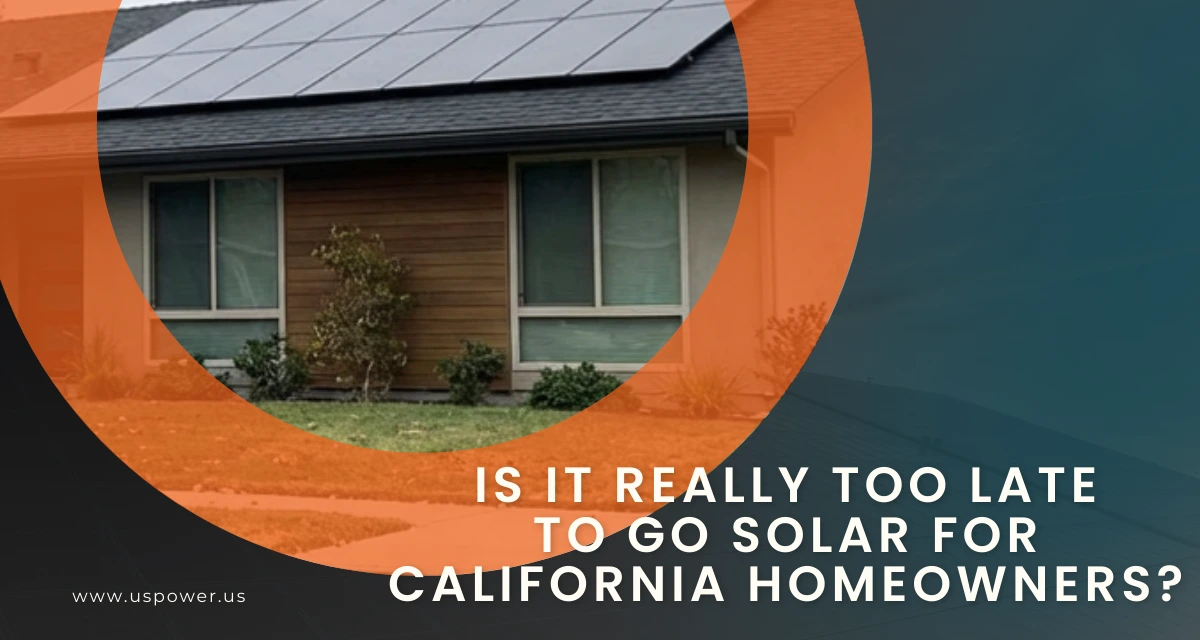The Overlooked Costs of Solar Ownership in California

Solar and Roofing Advisor
Explore California’s 2025 solar ownership costs—cleaning, insurance, inverter replacement, and battery maintenance for lasting performance with US Power.

Switching to solar energy is one of the smartest investments California homeowners can make—especially with rising utility rates and California’s long-term push for clean energy. But while solar systems are designed to last 25 years or more, they still come with ongoing costs that homeowners should understand to get the most out of their investment.
In 2025, solar ownership remains an excellent financial and environmental choice, but transparency about maintenance, monitoring, and ownership expenses helps prevent surprises down the line. This guide from US Power, a trusted Southern California solar installer and exclusive partner of QCells, breaks down everything homeowners should know about long-term solar costs.
Why Understanding Ongoing Solar Costs Matters
Many homeowners assume that once solar panels are installed, the costs end there. While the savings on electricity bills are substantial, solar systems—like any major home investment—require care and periodic expenses to maintain peak efficiency.
From inverter replacements to panel cleaning and insurance adjustments, these costs are manageable when planned for—and often offset by the significant energy savings solar provides each year.
Think of solar as owning a car: routine maintenance keeps it performing smoothly and prevents costly breakdowns later.
1. Routine System Maintenance and Cleaning
Southern California’s sunny weather is perfect for solar energy production, but it also means dust, bird droppings, and pollen can accumulate on panels. Over time, debris can block sunlight and reduce panel efficiency by up to 20%.
Typical maintenance includes:
- Panel cleaning: Most homes benefit from professional cleaning once or twice a year, costing between $150–$300 depending on system size.
- Visual inspections: Checking for debris, shading from trees, or loose connections.
- Annual system check-up: Some installers offer yearly inspections to verify system health, seal integrity, and inverter performance.
💡 Pro Tip: Homeowners who live near highways, farmland, or coastal areas may need more frequent cleanings due to higher dust or salt exposure.
2. Inverter Replacement or Repair
While solar panels can last 25–30 years, inverters typically last 10–15 years. This component is critical—it converts the solar energy (DC) into usable household electricity (AC).
Cost of replacement:
Expect to spend around $1,000–$3,000 depending on the system capacity and inverter brand.
Smart strategy: Choose solar systems that come with long inverter warranties or integrated components from trusted manufacturers. US Power recommends QCells systems paired with high-quality inverters that provide robust performance guarantees, minimizing future costs.
3. Monitoring and Connectivity Fees
Modern solar systems include online monitoring, allowing homeowners to track real-time energy production. Many manufacturers offer free monitoring for the first 10 years, but afterward, a small annual or cellular fee ($100–$200/year) may apply to maintain cloud data access.
For homeowners who want enhanced oversight, third-party monitoring services can provide advanced analytics, production reports, and alerts for a modest subscription fee.
4. Roof Maintenance and Replacement Considerations
Solar panels are installed directly on the roof, so it’s important to ensure your roof is in good condition before installation. However, roofs don’t always last as long as solar panels, which means some homeowners may need to remove and reinstall panels during a future roof replacement.
Estimated cost: $1,000–$3,000+ depending on system size and roofing type.
To avoid this scenario, US Power advises homeowners to inspect and reinforce their roof before installation. A proactive approach can save thousands later.
5. Insurance Coverage Adjustments
Adding solar panels can slightly increase your home’s insurance premium, typically by $50–$150 per year, as your total property value rises.
Solar panels are generally covered under a standard homeowner’s policy, but it’s wise to:
- Confirm coverage for natural disasters, such as wind or fire (common in California).
- Ensure your insurer recognizes the panels as a permanent fixture.
- Check for coverage on acts of God (not always included under manufacturer warranties).
A quick policy update ensures peace of mind if any damage occurs.
6. Utility Connection and Billing Charges (Post-NEM 3.0)
Even with solar, most homeowners remain connected to the electric grid. Utilities such as Southern California Edison (SCE) and LADWP charge a small monthly connection fee, generally between $10–$20 per month.
Under California’s Net Billing Tariff (NEM 3.0), homeowners still save substantially, but exported electricity earns lower compensation than in the past. This means your electricity bill won’t drop to zero—but it will still be dramatically lower compared to non-solar homes.
Additionally:
- Time-of-Use (TOU) rates reward off-peak energy use.
- Demand charges may apply to larger homes or multi-unit properties.
💡 Tip: US Power consultants design systems that optimize production around TOU schedules, maximizing your bill credits and ROI.
7. Warranty, Labor, and Diagnostic Fees
Solar warranties typically include:
- Panel warranty: 25–30 years (covering power output degradation).
- Inverter warranty: 10–15 years.
- Labor/workmanship warranty: 10 years on average.
However, once warranties expire, homeowners may need to pay for diagnostics or small repairs, which typically cost $150–$300 per visit.
To minimize these costs, US Power offers systems backed by long-term product and labor warranties, ensuring homeowners enjoy peace of mind without surprise service bills.
8. Property Taxes and California’s Solar Exemption
California’s Active Solar Energy System Exclusion currently prevents homeowners from paying additional property taxes for their solar installation. This exemption, however, is set to expire after 2026 unless extended by legislation.
What this means for homeowners:
- Existing systems installed before the expiration remain exempt.
- New installations after 2026 may increase assessed property value and tax obligations.
Planning solar installation before the deadline helps homeowners lock in this valuable tax benefit.
9. Natural Degradation and Production Loss
All solar panels slowly degrade over time—typically 0.5% to 1% annually. This is a natural process as materials age and weather exposure affects output.
For example, a 400-watt panel may still produce around 360–370 watts after 25 years.
Choosing high-efficiency panels like QCells helps offset this minor decline, maintaining consistent long-term production and savings.
10. End-of-Life Removal or Replacement
After 25–30 years, panels may reach the end of their efficient life cycle. When that time comes, homeowners will need to remove and replace them.
Typical removal cost: $1,000–$2,000, depending on roof access and system complexity.
Disposal or recycling: California classifies panels under electronic waste (e-waste) regulations, which require safe, eco-friendly disposal or recycling.
As recycling technology advances, it’s expected that solar panel recycling will become more affordable and efficient by the 2030s.
11. Battery System Maintenance and Replacement
For homeowners with solar battery storage (such as Tesla Powerwall, Q.HOME, or Enphase), additional costs come into play.
Battery lifespan: 10–15 years, depending on use and depth of discharge.
Replacement cost: Around $8,000–$12,000 for a whole-home battery.
Some batteries require software updates, monitoring subscriptions, or warranty renewals after the initial coverage ends. However, battery systems provide essential backup power and energy independence, especially during California’s frequent grid outages.
12. Optional Monitoring and Service Plans
To simplify system ownership, many homeowners choose annual service plans that include:
- Panel cleaning and inspections
- Performance monitoring
- Preventive maintenance visits
- Extended labor warranties
These programs typically cost $200–$500 per year but can significantly reduce the likelihood of performance loss or unplanned repair costs.
For example, US Power’s service programs include periodic maintenance and system performance checks, helping clients keep their solar systems operating at maximum efficiency year-round.
Quick Reference: Average Ongoing Solar Costs (2025)
| Category | Frequency | Estimated Cost |
|---|---|---|
| Panel Cleaning | 1–2× per year | $150–$300 |
| Inverter Replacement | Every 10–15 yrs | $1,000–$3,000 |
| Monitoring Fees | After 10 yrs | $100–$200/yr |
| Roof Reinstallation | As needed | $1,000–$3,000+ |
| Insurance Add-On | Annual | $50–$150/yr |
| Utility Fees | Monthly | $10–$20/mo |
| Labor/Diagnostics | As needed | $150–$300/visit |
| System Removal | Every 25–30 yrs | $1,000–$2,000 |
| Battery Replacement | Every 10–15 yrs | $8,000–$12,000 |
Long-Term Savings vs. Ongoing Costs
While the list of costs may seem extensive, the long-term financial benefits of solar energy far outweigh the ongoing expenses. The average California homeowner saves $1,500–$2,500 per year on electricity bills, totaling $40,000–$60,000 in savings over 25 years.
Even after accounting for maintenance, monitoring, and small utility fees, homeowners typically achieve a return on investment within 6–9 years—especially when combining solar with efficient panels and proper maintenance.
How to Minimize Long-Term Solar Costs
Homeowners can easily reduce future expenses with a few smart strategies:
- Work with reputable local installers. US Power provides transparent warranties, high-quality components, and continuous post-installation support.
- Choose reliable panels and inverters. QCells panels offer industry-leading durability and 25-year performance warranties.
- Schedule regular cleaning and monitoring. Preventive maintenance ensures peak energy production and early detection of issues.
- Stay updated on policy changes. Keep track of California’s tax exemptions, incentive programs, and NEM updates.
Power Your Home the Smart Way
Solar ownership in California continues to deliver outstanding savings and environmental benefits in 2025. While there are ongoing costs—such as cleaning, inverter replacements, and insurance adjustments—they remain minor compared to decades of reduced energy bills and increased property value.
By choosing trusted products like QCells solar panels and partnering with experienced local installers like US Power, homeowners can enjoy reliable, low-maintenance solar systems that perform efficiently for decades.
If you’re ready to invest in high-quality solar that’s built to last, US Power offers expert installation, premium QCells panels, and long-term support for Southern California homeowners.
Get a free solar consultation today to learn how much you can save—and how to keep your system performing at its best for years to come.
Related Articles
Our Related Blogs
Discover savings and reliability with solar + battery systems through US Power.
Follow our guide to secure the 30% solar tax credit in California before 2025 ends.
Step-by-step guidance for transferring solar systems during your home sale.
Our Solar and Roof Brand Partners








We empower communities and businesses to harness clean, renewable solar energy solutions that drive sustainable growth.
Ready to Own Your Power? Call us today!
818-650-8010
Copyright © 2025 US Power - Axia by QCells. All Rights Reserved.
Privacy is important to us, so you have the option of disabling certain types of storage that may not be necessary for the basic functioning of the website. Blocking categories may impact your experience on the website.
Essential
These items are required to enable basic website functionality.
Personalization
These items allow the website to remember choices you make (such as your user name, language, or the region you are in) and provide enhanced, more personal features.
Marketing
These items are used to deliver advertising that is more relevant to you and your interests.
Analytics
These items help the website operator understand how its website performs, how visitors interact with the site, and whether there may be technical issues.
We and our third-party partners use cookies and other technologies to enhance and track your experience on this site, conduct analytics, and personalize marketing to you. By using the site, you agree to our use of these technologies, including recording and monitoring your interactions with the site.
Get an instant solar estimate using satellite!









